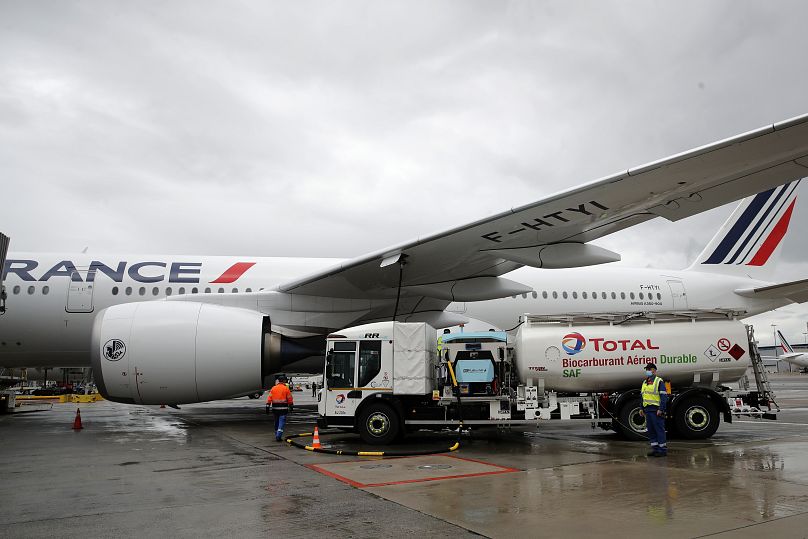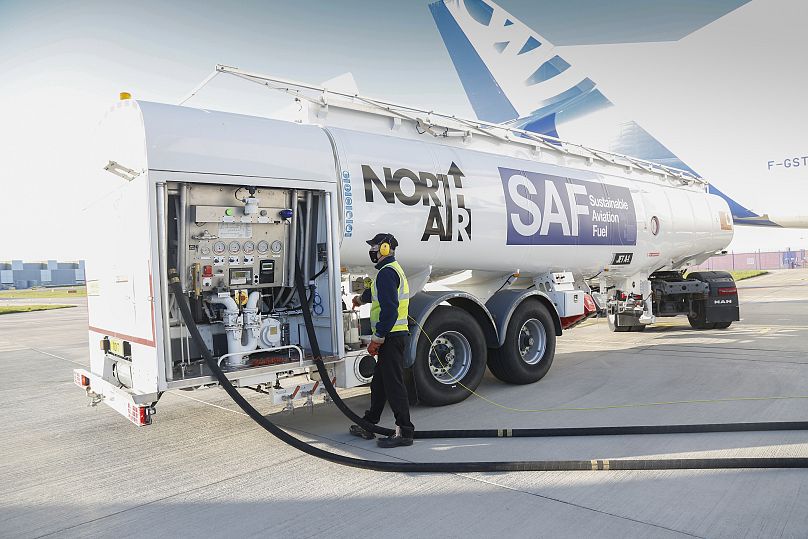Sustainable aviation fuels are one of the key measures to reduce aviation emissions. We delve into how they are currently being used, how they can be made, and what concrete impact they could have on the environment.
Flying is responsible for 2.5 per cent of the world’s CO2 emissions, so reducing its climate impact is crucial to mitigating climate change.
Despite the problem’s importance, most people have barely been heard of one of the biggest innovations in recent years to reduce flight emissions.
Sustainable aviation fuel - or SAF - is the umbrella term for the creation of jet fuel from sources other than fossils.
Sourced from cooking oils and waste animal fats, SAF is able to reduce the carbon emissions of flights by up to an incredible 80 per cent.
How does SAF reduce emissions?
When a jet’s fossil-based fuel, kerosene, is burnt, it releases the carbon from the fossil-fuel source into the atmosphere. And for every bit of kerosene burnt, we permanently reduce the amount of fossil fuel available.
Because SAF doesn’t come from finite fossil sources, its use is immediately more sustainable and renewable.
For SAF made from plants, the CO2 absorbed by the plants during their growth is equivalent to the CO2 released when burnt in an engine. This makes the burning of plant-based fuel essentially carbon neutral.
“Lifecycle carbon emissions are calculated by netting off any carbon that was removed from the atmosphere by the sustainable feedstocks against the carbon emitted over the lifecycle,” explains Andreea Moyes, Global Aviation Sustainability Director for Air bp.
Burning SAF isn’t completely carbon neutral though, as figures still have to take into account the emissions from producing the fuel - such as for transportation and refinement of the fuel.
But it’s still a significant improvement to have jet fuels that are carbon neutral across their sources’ life cycles.
How is SAF made?
The two main commercial aeroplane manufacturers - Airbus and Boeing - both have partnered with fuel companies to develop SAF. Airbus is working with Air bp and Total, while Boeing is working with SkyNRG.
Both groups have looked to similar renewable sources to create their SAF. These feedstocks include things like cooking oil and palm oil, as well as the waste oils from animals and plants.
Other feedstocks for SAF include the solid waste that comes from peoples’ homes and businesses. Things like paper and food scraps that might have been headed to the dump can instead be repurposed to create SAF.
The feedstock’s sustainability is then certified by an official body.
“For a feedstock to be certified, a broad range of criteria must be met,” details Moyes. These include the impact on food production, use of land and maintenance of local biodiversity.
Using SAF for flight
Once the renewably-sourced fuel has been created, it is mixed with kerosene to make a 50-50 blend of SAF and traditional fuel.
This fuel blend can be used in exactly the same way as normal jet fuel: There is no need for any modifications to the aeroplanes it is put in. This reduces infrastructure costs greatly.
SAF isn’t used universally across aircraft yet, but it is growing. More than 150,000 flights have been powered by SAF since the first flight in 2008 and the first commercial flight in 2011, which was run by KLM.
Air BP has supplied SAF at 16 locations across three continents with a supply chain already established in Sweden.
What else can it do?
As well as being nearly carbon-neutral, SAF can also reduce direct emissions. Compared to kerosene, SAF has 90 per cent reduced particulates, and 100 per cent reduced sulfur - improving air quality in plane flight paths.
SAF also burns more efficiently, allowing planes to use less fuel in total across a journey.
It could also provide an economic benefit in some countries, as it doesn’t require sourcing fuel from a smattering of oil-rich nations: SAF can be produced anywhere with waste products.
What SAF can’t do
Although SAF may sound like the perfect solution to the aviation industry’s impact on the planet, it’s important to note it isn’t a panacea to flying’s climate change issues.
“The problem is the need to produce SAF in a ‘green’ way,” explains Dr Duncan Walker, senior lecturer in applied aerodynamics at Loughborough University.
“They still produce carbon when burnt, so the carbon saving has to come in the production of SAFs,” he notes.
“Whichever method is used (grown bio-fuels or synthesised e-fuels) the infrastructure and energy requirements are huge. We need huge amounts of electricity to produce SAF on a suitable scale.”
“That electricity must also be green - so we need much more solar or wind (or even nuclear power) than we have at the moment,” he says.
The future of SAF
Long-haul commercial flights have largely been made possible by the energy density of jet fuel, so replacing it is difficult.
“Even by 2050, jet fuel is likely to still be the main source of energy for aviation, since hydrogen is unlikely to be able to address long-haul wide-body aircraft propulsion in this time frame,” says Moyes.
“So SAF is critical to meeting the industry’s 2050 (sustainability) goals,” she adds.
As more and more airlines start to use SAF, the market cost will hopefully drop and make it more economically viable. Some airlines are giving customers the option to fund the use of SAF as an extra cost in tickets.
The aviation industry has also called on governments to create policies encouraging the growth of SAF. “Increasing production requires long-term policy certainty to reduce investment risks, as well as a focus on the research, development and commercialisation of improved production technologies and innovative sustainable feedstocks,” Moyes concludes.
The first-ever 100 per cent SAF flights not using a blend with kerosene also took place in the last year. And on October 29, Airbus, Dassault Aviation, ONERA, the French Ministry of Transport and Safran launched the first in-flight study of single-aisle aircraft running on unblended SAF.














